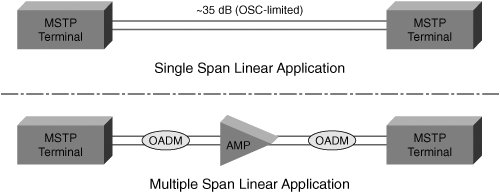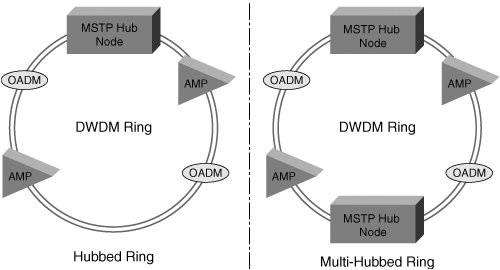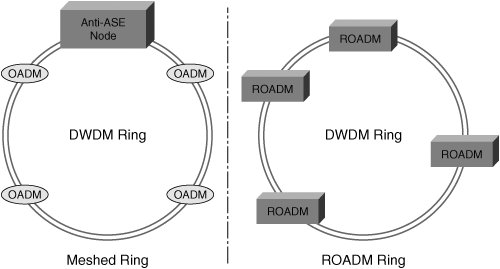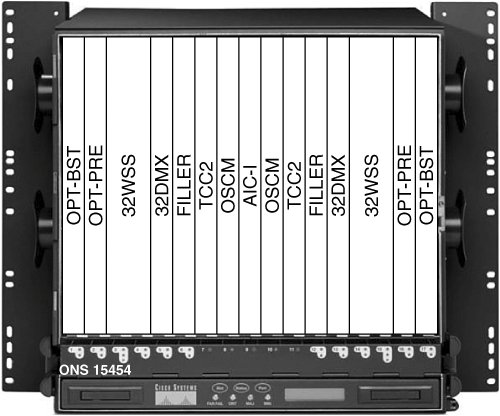ONS 15454 MSTP Supported Network Configurations
| The ONS 15454 MSTP supports a wide array of network configurations, ranging from point-to-point (linear) to various ring topologies. The design rules and plug-in interface requirements also vary per topology type. Chapter 10, "Designing ONS 15454 MSTP Networks," covers design rule considerations. This section details some of the interface card requirements, where appropriate, but is not intended to provide an exhaustive list of card/node requirements for each network topology implementation. Linear TopologiesThe ONS 15454 MSTP can be deployed in linear, point-to-point applications, in which the A and Z ends of the topology spans use 32-channel terminal nodes: ROADM or fixed-channel add/drop. The linear topology can employ OADM sites midspan or can be characterized by a single amplified/unamplified link from terminal to terminal. For single-span implementations, the terminal-to-terminal distance is usually most limited by the optical reach of the OSC card because it operates outside the EDFA amplifier operation pass-band. Both the OSCM/OSC-CSCM interface cards support a 37-dB end-to-end link budget. Additionally, the OSCM interface card can support a 37-dB end-to-end link budget. Figure 9-22 illustrates the two variations of linear topologies supported on the ONS 15454 MSTP system. Figure 9-23 represents a typical ONS 15454 MSTP shelf layout for the linear topology. Figure 9-22. ONS 15454 MSTP Linear Topologies Figure 9-23. ONS 15454 MSTP Terminal Shelf Layout Ring TopologiesThe ONS 15454 MSTP provides support for a number of ring-based topologies. Ring systems are characterized by single or multiple 32-channel terminal nodes, networked with intermediate OADM sites. The ring configurations provide the additional functionality of wavelength channel protection, depending on the type of client transponder/muxponder interface card used for wavelength channel insertion. The ring topologies can be segregated into the following categories:
Hubbed/Multihubbed RingsHubbed rings are typified by a single 32-channel terminal node, in which all ring wavelength channels are terminated. Intermediate ring sites are OADM or pass-through nodes. Wavelength channels cam be protected or unprotected. Unprotected DWDM channels can be reused on any ring East/West span. Multihubbed rings operate in the same manner; however, this topology uses two or more hub nodes on the ring. Protected channels must terminate at a minimum of two hub nodes on the multihubbed ring. Figure 9-24 illustrates the hubbed ring topologies supported on the ONS 15454 MSTP system. Figure 9-25 represents a typical ONS 15454 MSTP shelf layout for the hubbed ring topology. Figure 9-24. ONS 15454 MSTP Hubbed Ring Topologies Figure 9-25. ONS 15454 MSTP Hub and OADM Shelf Layout Meshed RingsUnlike hubbed rings, meshed rings do not use terminal/hub nodes in the ring topology. All the nodes in a meshed ring topology are OADM sites. DWDM wavelength channel protection and unprotected channel reuse is available, as with the hubbed ring scenarios. The meshed ring introduces a new network node type: anti-ASE (amplified spontaneous emissions) node. The anti-ASE node is used to mitigate the potential effect of noise accumulation on unused, amplified channels, to keep from destroying the quality of DWDM channel transmissions. The anti-ASE node can be deployed using one of two methods:
Reconfigurable RingsThe reconfigurable optical add/drop (ROADM) concept was covered earlier in this chapter. With this topology, any-to-any DWDM wavelength channel assignment is possible. DWDM wavelength channel protection and unprotected channel reuse is supported with this topology also. The ROADM shelves use the 32 WSS/32 DMX multiplexer/demultiplexer combination for OADM and terminal shelves, or a mixture of ROADM and fixed-channel add/drop nodes. Figure 9-26 illustrates the meshed ring and ROADM topologies supported on the ONS 15454 MSTP system. Figure 9-27 represents a typical ONS 15454 MSTP shelf layout for the ROADM topology. Figure 9-26. ONS 15454 MSTP Meshed Ring and ROADM Topologies Figure 9-27. ONS 15454 MSTP ROADM Shelf Layout |
EAN: 2147483647
Pages: 140
- ERP Systems Impact on Organizations
- ERP System Acquisition: A Process Model and Results From an Austrian Survey
- Distributed Data Warehouse for Geo-spatial Services
- Intrinsic and Contextual Data Quality: The Effect of Media and Personal Involvement
- Relevance and Micro-Relevance for the Professional as Determinants of IT-Diffusion and IT-Use in Healthcare




